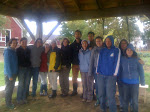This morning, our group visited the various pastured (or non-pastured) animals of the farm. We discussed their food needs as well as the breed's specifications. We do this a lot with Olivier and we keep learning new things!
These are our Devon Red grass-fed beauties. They are up in a far field from the farm, munching on hay in the morning and given new pasture in the evening. We keep them penned with electrified fencing--a permanent line running around the whole field and an easy-to-install moveable fence for each day's offerings. We were discussing how to tell if the grass is suitable, how much room for grazing each day, and a little about the "zone of repugnancy"--the area around a cowpie that a cow refuses to graze, even after a year or two!This is Emily giving our pigs a scratch behind the ears. They will go to "be processed" the second week of November. For now, they are enjoying warm, sunny days running around their paddock. We feed them a "pig chow" but they enjoy the leavings of our harvests as well as scraps from our table.
These chicks, about four weeks old, are of the breed that grows quickly and are ready for "processing" at about 8 weeks old. They are chunky little birds who don't walk well and they are, in this photo, learning to each "scratch," crushed corn and other grains that will add fat to their diet to keep them warm.
This is Emma bonding with our Border-Leicester sheep and lambs. They are also on a rotational grazing program--fenced into a paddock where they eat up the grass offered and are ready to move on the next morning. I'll try to catch this on video--they are so happy for a new paddock!
Our afternoon consisted of a two-part lesson. Carlon showed us her method for making home-made yoghurt from our excess milk. She also worked with us to clear the homestead garden of excess grass to make bigger planting beds. And, of course, we worked on our compost.





No comments:
Post a Comment